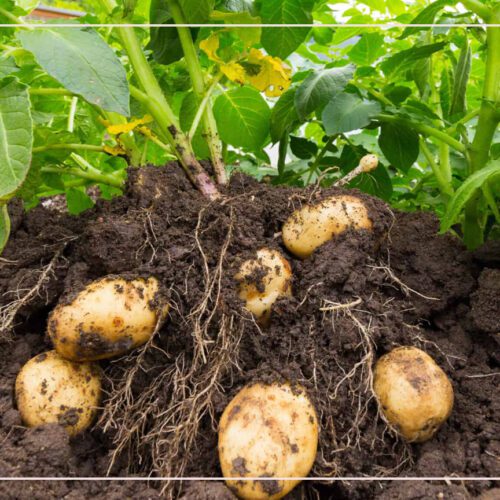
Agriculture, is the most important economic resource, and today we will be talking about a very interesting agricultural crop, which is bean cultivation of all kinds.
I will show you all how to grow beans in two places: on agricultural land (soil) and at home, and I will answer several questions that have been asked of agricultural specialists.
Growing Beans
Growing beans is a very famous agriculture in all Arab lands, and it’s the most important agricultural crop traded in markets.
Also, beans are considered healthy food for poor people and also for rich people, so beans contain a lot of nutritional elements (fiber, vitamins, minerals), and beans are also used for strengthening the human body’s immunity, muscle tonics, and cures for anemia and cholesterol patients because they contain potassium.
How to Grow Beans
The planting time for beans is in autumn; it needs cold weather, especially in mountains, and the planting of beans starts from the beginning of October until the end of November. Before starting the planting, we must know how to prepare the soil by adding organic fertilizers.
Prepare the soil before planting beans
Before planting beans, we must prepare the soil to reserve new types of agricultural crops, so we must add old organic fertilizer from cows’ waste or poultry waste, and we also need to add triple superphosphate fertilizer.
After we added the organic fertilizer and superphosphate, we must mix the soil by plowing it very well vertically until the soil becomes soft. After that, we should add ammonium sulfate, potassium sulfate, and agricultural sulfur.
We must mix all the quantities very well and then sprinkle them on the soil surface. After this process, we can now divide the agricultural land by horizontally planning for bean planting.
Now that you know the process of preparing the soil and the date for planting, here is how to grow beans by following these steps:
- Make horizontal lines by making 8 lines, and the distance between these lines must be 90 cm.
- Make small holes in the lines 5 cm deep, and between these holes must be 25 cm. We must put 3 bean seeds in each hole, and after that, we put the water hose above all the holes for drip irrigation if used.
- The second irrigation must be after one month since the beginning of bean planting and must be repeated every 15 days.
- After 4 months, the bean crop matures, and after that, the process of harvesting begins, and that’s how to grow beans.
Growing peanut
Peanut cultivation is a root transplantation (the peanut germinates on roots inside the soil, not in the branches). Peanuts are legumes, so they contain a lot of proteins, like all kinds of beans.
But in peanuts, there are some nutrients like antioxidants, which are considered one of the most important anticancer elements, and vitamin E (beneficial for skin). That’s why cosmetics factories prefer peanut cultivation.
Time for planting peanuts
Peanuts plants are grown in warm months, specifically at 25°C with sunny weather, and in general, the time for planting peanuts starts in April until the first half of June.
Averagely, peanut cultivation takes approximately two months or two months and a half (60 days) until the process of harvesting and obtaining ripe seeds.
How to grow peanuts
Before we start planting peanuts, we must prepare the soil by adding organic fertilizers, and after that, we must plowing the land in order to aerate the soil, mix organic fertilizer, and also increase the soil drainage property of irrigation water. After doing these processes, we should now know how to grow peanuts by following these steps:
- Apply the organic fertilizers and add ammonium sulfate and potassium sulfate to them. After that, we start planning the land horizontally and regularly.
- The distance between the lines must be 60 cm. After that, we should make holes 5 cm deep and put 4 peanut seeds in each hole.
- The distance between the holes must be 20 cm. After that, we cover the holes with soil and water, or we use drip irrigation.
- Peanuts are harvested after two months, or two months and a half. This process can be done manually or by agricultural machines by rotating the soil and removing the peanuts from the bottom of the soil (plant roots).
Growing Egyptian beans
Cultivation of Egyptian beans is simple; planting of Egyptian beans begins in October and November, which is winter; planting of Egyptian beans takes place on the mountain during cold days.
How to grow Egyptian beans
This process of growing Egyptian beans takes place through several basic stages that must be followed in order to guarantee satisfying results, so you all must follow these steps:
- The soil must plow very well; the Egyptian beans are growing in all types of soil except the very salty and poorly drained soil.
- We should plan the land horizontally and make holes between the lines 5 cm deep, and then we put 2 or 3 seeds of Egyptian beans we get from agricultural pharmacies.
- The distance between the holes must be 20 cm in order to ensure that the roots do not get tangled.
- The soil must be irrigated before and during the planting, and that is the first irrigation, just to know that the Egyptian beans don’t need a lot of water.
- Egyptian beans are not stressful to the soil, so they don’t need fertilizers in large quantities. If there is fermented organic fertilizer, it is preferable to add it during planting.
- After two months, you will find the Egyptian beans have grown, and the sign of maturity is the yellowing of the lower pods at the bottom of the plant.
Growing green beans
Growing green beans is the best agricultural product because of the great desire to consume them, and green beans are also used in many foods and food industries. I explained how to grow green beans in the previous paragraph.
Planting green beans at home
A lot of people want to learn how to plant green beans at home because it is important to consume green beans in large quantities throughout the year in every home, rooftop, or home garden. If it exists or is in any sunny place at home.
And here is the process of how to grow green beans at home easily by following these steps:
- Agricultural soil must be brought first and put in large plant propagators, and then we mix it with organic fertilizer and make the soil flat.
- Now we should plan the soil horizontally and make small holes; the distance between holes must be 10 cm.
- From the market, bring the dried beans (the brown beans), then put 2 or 3 beans on it and cover it well with soil.
- Water the soil until it is very wet. Repeat this irrigation every 2 days. After 2 weeks, you will recognize that the green leaves appear above the soil surface.
- After 3 months of planting, you will also recognize the flowers that appeared, and in 4 months, you can start the harvest as a result of complete growth.
Growing Soybean
Soybean is one of the legumes, and it’s an oil seed. Few people know about soybeans, but the planting of soybeans is very important because soybeans include a lot of nutrients that do not exist in other kinds of beans.
Soybean includes protein and fiber that are very beneficial for digestive processes in the body. It also contains a lot of amino acids that regulate insulin in the blood and reduce the incidence of atherosclerosis and heart disease.
Time for planting soybeans
Like the other agricultural crops, there is timing for planting, and the time for planting soybeans is in July, and the time for harvest is in October, so it takes about 3 months to grow.
How to grow soybeans
Preparing the soil before planting is the best thing you can do, and by following the process, the result will be amazing without any problems. Here is how to grow soybeans by following these steps:
- You must plowing the soil very well and horizontally the first time and leave it for about 5 days for soil aeration, then plowing it again and making it flat.
- Now you must put organic fertilizer 20 cubic meters per feddan and put superphosphate and agriculture sulfur to protect the plant from root rot.
- plan the soil horizontally, and I prefer it to be from north to south in order to benefit from the sun.
- Make holes 5 cm deep, and the distance between the holes must be 20 cm, and put 2 seeds in each hole.
- Start watering the soil after planting the soybeans very well, or use the drip irrigation method.
- After 3 months, you can start harvesting soybeans, and that is the end of growing soybeans.
Growing beans with cotton
Growing beans with cotton is one of the traditional home methods that parents and teachers do in order to explain how to grow beans in a simple way. Here is how to grow beans with cotton at home by using simple tools. Now follow these steps:
- Bring a cup of water, beans, cotton (a soil substitute), and an empty jar.
- Put a layer of cotton in the jar and water it very well until it’s absorbed by the cotton.
- Put the beans on the surface of the cotton equally.
- Leave the beans in a sunny place, and after 2 days, the beans will grow into roots.
- After 5 days, you will recognize the stem, and some small leaves will appear.
- After 2 weeks of planting the beans with cotton, they must be transferred to the soil in order to gain nutrients that help the growth of the beans.
Time for planting beans
Like other plants, there is timing for planting, so the time for planting beans starts in the beginning of October and November. Some farmers prefer to plant beans in mountainous areas with cold climates.
Growing beans in winter
Planting the beans in winter (October or November) so the weather becomes cold is acceptable, and there is no objection to starting planting in January.
But agricultural experts prefer to start planting the beans in October because the sun exists to ensure rapid growth of the plants, and to know the process of growing beans in winter, it’s included in the section on how to grow beans. This process doesn’t need any controlling of climatic factors like greenhouses because beans were originally planted in winter and are not growing in summer.
Growing beans at home
A lot of people are interested in knowing about the planting of beans at home in order to benefit from beans for cooking and personal use, and also in order to save money because beans are highly consumed in a lot of Arabic families.
How to grow beans at home
The first stage in growing beans at home is getting fully mature beans, which is the condition for the success of the agricultural operation. Here is how to grow beans at home by following these steps:
- Bring a plastic or glass jar and fill it with water and beans. Leave it for 5 hours in order to help the water with the germination process.
- Bring a plastic bag or box and also tissue paper; put the tissue in the bottom of the box; and water the tissue.
- Put the mature beans on the surface of wet tissue, cover the beans with a layer of tissue, water them again, and then close the box.
- After 7 days, we make sure that the germination process is good. After that, we brig the soil with organic fertilizer, put the seeds in holes, and cover them with the same soil.
- Water the soil by filling it with water, and follow up on the irrigation regularly.
- Fertilize the soil by adding N.P.K. (nitrogen, phosphorus, potassium).
- Harvesting begins around 120 days after the beans reach maturity.
Growing beans by drip irrigation
Growing beans by drip irrigation is a method used in the desert because there is too little water in it, and this method is useful for water rationalization.
Drip irrigation is processed by extending water hoses, and there are holes so water can drop regularly. A bean plant needs about 1600 cubic liters of water, and drip irrigation is the only way to regulate the water distribution process. Growing beans by drip irrigation is the best method in dry lands, and a lot of farmers and investors prefer it.
Growing beans in desert lands
Some farmers have to grow beans on desert lands because owning this land or working on it makes growing beans in desert weather possible, but there are conditions that must be followed in order to ensure that there are no problems, so the conditions for growing beans in desert lands are:
- The used soil should be low in salinity.
- The timing of planting beans should be in the third week of October or the first week of November.
- The process of planting beans should use modern irrigation techniques (drip irrigation).
By following the 3 conditions and disease control, which may affect the roots or leaves, and controlling insects, you can grow beans on desert lands properly.





